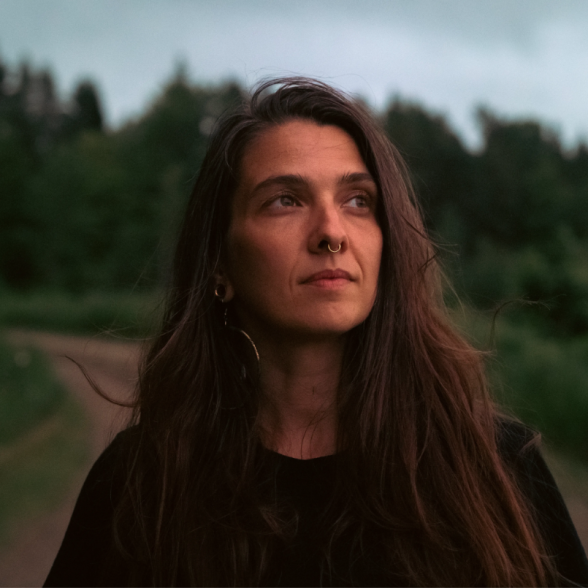If you haven’t listened to, read, watched, or seen one of multidisciplinary artist Soleil Launière’s works while in Montreal, you’ve been missing out.
For the last five years Launière has been creating art in almost every field at a breakneck pace. In 2023 alone she: premiered her first album on Spotify, Taueu (“in the centre”); published her first book, Akutu (“suspended”); acted in a short film, Katshinau (“Dirty Hands”); and created two stunning (click the link, you’ll thank me later) visual art pieces, Takutatinau and Ninanamapalin – My Body is Trembling.
In 2019, Launière founded her production company Auen Productions to “interweave the presence of the two-spirited body and experimental audiovisual while drawing inspiration from the cosmogony and sacred spirit of the animals of the Innu world and express a thought on silences and languages through the body.” Launière has directed seven completed performance works so far, and she has another titled Takutauat on the way.
Earlier this October, I attended a production of Launière’s latest work, a performance art piece titled Aianishkat (“One Generation to the Next”) at Agora de la Danse theatre. The show starred Launière, her mentor Rasili Botz, and her three-year-old daughter Maé-Nitei Launière-Lessard, bringing together three generations of Indigenous women to explore the process of intergenerational pedagogy. The first notes I took after leaving the show were: “Never before have I seen such beautiful hair,” “The child did everything right,” and “Merci, bon nuit.”
I can’t call it “hairography” because that word would cheapen Launière’s use of hair in this performance. Nor can I leave it at “beautiful” because that would leave out the significance behind its use: Launière utilized her own and Botz’s hair to explore how both trauma and knowledge are passed down through generations.
Aianishkat began with Botz alone on stage, carefully unwrapping a blanket to reveal chunks of cut black and brown hair, which she spread across the floor as if they were ashes. Then, while braiding her own hair, she fashioned the blanket into a makeshift basket and collected what hair had been thrown away.
Fabric is integral to this piece; most of the props were either clothing or blankets, which the actors manipulated into different forms to serve a unique artistic purpose. Launière entered the stage shortly after Botz had finished cleaning the floor, carrying a basket of her family’s laundry and sitting down to fold the pieces in an orderly fashion. Her daughter soon joined her onstage.
Prior to the performance, my friends and I debated how a toddler could participate in this piece. We wondered how a show could run orderly when one of the actors may not understand the concept of a script or cues. I was pleasantly surprised by how perfectly Launière’s daughter performed. Although her actions were, like any toddler’s, unpredictable and spontaneous, everything she did fell completely in line with the performance. Botz and Launière easily ran with the child’s improvisations, occasionally using wind-up toys to coax her back on stage if she wandered into one of the wings. Her sheer joy at accompanying her mother on a stage littered with interesting objects, sounds, and shapes delighted the audience. She not only added a lightness to the second half of the 90 minute show, but also an air of hope for the future.
Prior to the work, the only performance art I’d seen was a “deconstructed” production of Shakespeare’s Romeo and Juliet performed at Toronto’s Young People’s Theatre. It was titled What if Romeo and Juliet… and had four actors each playing changing parts of the scenery from integral scenes in the original play. One actor played a fountain, squatting and flailing his arms. Someone else was a sword, standing on their tippy toes and pointing their fingers at the ceiling. Another actor played the floor.
It left a bad taste in my mouth when it came to the phrase “performance art.” The idea of a primarily improvised production, mainly told through movement instead of words, didn’t particularly interest me. After What if Romeo and Juliet…, I didn’t see how performance art could function well as a medium.
Yet I became intrigued by Aianishkat as soon as the show lights came on, revealing Botz. I came to a realization about performance art 30 minutes later when all three actors were brought on stage together. The way they interacted was fascinating and told a story all on its own. I realized that nobody on stage was trying to act out a storyline – they were instead performing a truth. Through movement, they were acting out the process of intergenerational teaching. They visually embodied the struggle and perseverance that Indigenous communities have and continue to demonstrate in the fight to uplift their culture in the face of colonization. The power behind this performance stood in the unspoken bond between mentor and student, mother and daughter, artist and audience.
Launière ended Aianishkat with the only spoken phrase of the performance, “Merci, bon nuit.” She said this with her daughter cradled in her arms, both waving goodbye to the audience and smiling. It didn’t feel right; I thought she should have said “you’re welcome,” because a “thanks” on my part was in order.
We are all lucky to live so close to Launière’s work. Her next performance art piece, Takutauat, is still in production – updates regarding the time, place, and runtime will be available on her website, www.soleil-launiere.com. In the meantime, I’d implore any art lover in Montreal to treat themselves to one of her many art pieces available online including her book, visual artworks, and award-winning music on Spotify. You can also experience Launière in person at Mundial Montréal on November 19, the Marathon Festival aux Foufounes Électriques on November 20, and Cégep Saint-Laurent on November 29.

